Panel Beating - 4th March 2006
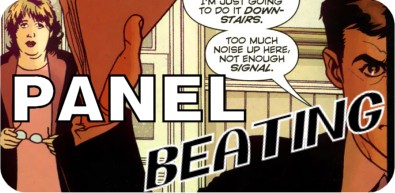
Hello, and welcome to Panel Beating. Yes, it's a terrible pun. But it's compulsory for comics-related columns to have a name that involves a terrible pun or gag of some kind. It's just the law. Anyway, this is Noise To Signal's new, weekly comics roundup. But those of you who are fans of longer reviews need not fear - those will still be a part of the site, as and when it seems necessary. However, we felt it would be nice to also offer a general selection of shorter, snappier reviews, as befits the way in which the majority of comics are published. As such, I'll be offering you my views on the comics I buy each week, usually posting on Saturday or thereabouts. Please note, though, that my reviews will be a reflection on my own reading habits, and not an attempt to cover a general wide spectrum week by week. As such, you'll see a lot of the same titles cropping up, and you'll also notice leanings towards certain genres, writers and characters. I make no apologies for this fact, but I hope you enjoy my take on things.
So let's get things started. And it's a big week if you're a DC fan - indeed, March is a big month if you're a DC fan - as the One Year Later event spins out of the pages of the universe-shattering Infinite Crisis miniseries. The DC universe is jumping ahead a year, a year in which Superman, Batman and Wonder Woman have all been missing. That's the focus of the main titles, although with Crisis yet to finish we still don't know which Earth, and which versions of which characters, we've been left with. After Crisis finishes, however, we're getting the ambitious weekly miniseries 52, which will fill us in on exactly what happened over the course of that year. For now, though, One Year Later has begun, and DC have immediately brought out the big guns...
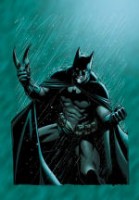 |
DETECTIVE COMICS #817
Publisher DC • Writer James Robinson • Pencils Leonard Kirk • Inks Andy Clarke
Part of the problem, of course, with this whole One Year Later deely, is the timing of it. You can obviously see what was meant to happen - Infinite Crisis finishes, leaving an unfamiliar, the-same-in-some-ways but different-in-others DC Universe. A new canvas for the writers and artists to play with. Then, we get One Year Later - the major titles start off at a point a year after the end of Crisis, while 52 starts at roughly the same time and fills in all the gaps. Great. Unfortunately, what's actually happened is that OYL has kicked off while Crisis still has two issues to go. Consequently, we have no idea in what context these characters are returning after a year off - we don't know how the land lies at the end of Crisis.
Obviously, then, the only thing to really do is exactly what James Robinson is doing with his eight-part storyline spreading over Detective Comics and Batman - make us not give a shit. Batman and Robin have been gone for a year. We don't know why they went, we don't know where they went, and we don't know why they're back. But we don't really care, because they are.
In essence, this is a fairly simple issue. Poison Ivy is terrorising Gotham again, albeit with apparently better powers than usual. Meanwhile, KGBeast has been murdered, and Gotham has a new "protector", who later turns out to be a rather surprisingly familiar face. Or, well, a familiar half a face, let's put it that way. So Commissioner Gordon (Commissioner! Gordon! See what I mean?) removes a familiar-piece of tarpaulin, a familiar light shines in the sky, and the boys are on the case. Marvellous. Art, meanwhile, is solid enough. I'm not familiar with Kirk and Clarke, but they basically seem to be following what's fast becoming a DC house style (the Jimenez, Morales, Reis type look), albeit with a quite cool, retro take on Bats himself. All quite textbook stuff, setting up the story proper kicking off in Batman #651.
That's not what matters, though. What matters is the feel of the thing. After all, Batman and Robin haven't been missing to us in the way they have to the citizens of Gotham who begin cheering when they see the Batsignal come on. However, what has been missing from Batman comics, for quite some time, is an adequate treatment of the character. For a multitude of reasons, it's been a long time since he actually felt like something to get excited about. This is, of course, something that DC have at editorial level taken the unusual step of acknowledging to be the case with all their major characters, and hence Crisis. In almost one fell swoop, however, James Robinson - and, while we're at it, how good it is to have the writer of Starman back - has made us care again. It's a new beginning, and by God it feels good.
It's all well and good, after all, doing something on the scale of Crisis and promising a new era. What DC have quite admirably acknowledged, however, is that something like that will eventually become meaningless (Zero Hour, anyone?) if you don't back it up by just telling bloody good stories. And with Robinson writing four issues of each title, followed by Grant Morrison and Paul Dini taking over the two books ongoing when he's done, they've bloody done it. They've made Batman a-list again. This isn't the phony hype of a twelve-issue Loeb-Lee run, though. This is the real deal. Roll on Busiek's Superman. Roll on the new age of DC. Hype, gimmicks, crossovers, nonsense aside - this is what it's all about. A
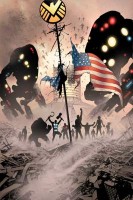 |
ULTIMATES 2 #10 (PICK OF THE WEEK!)
Publisher Marvel (Ultimate line) • Writer Mark Millar • Pencils Bryan Hitch • Inks Paul Neary
The Ultimates have been decimated. All their members have either been killed, incarcerated or dismembered, and two have revealed themselves as traitors. An international superpowered taskforce, using stolen technology, has invaded every major city in the United States. Oh, and the Statue of Liberty has been toppled into the Hudson River.
Fucking hell, this comic is good.
But all of that, of course, was last month. Millar has patiently spent the entirety of volume two (and some of volume one, come to that) stacking up the dominoes, tearing his team apart from the inside out. How could anything, then, possibly compete with issue #9, in which he nudged over the first domino and brought everything crashing down? Last issue was a succession of "Fuuuuuck" moments, as the Ultimates were put in a seemingly unwinnable position by their doppelgangers.
So what happens in this issue? Well, they fight back, of course. Every couple of pages of this issue features one of the team being extremely badass (Hawkeye? Fingernails?) - especially a great twist in the Tony/Natasha scenario - building up to a momentous final page (I'm not normally a fan of Ultimate Captain America, but damned if that didn't make me go "Hell, yeah!"). It's completely entertaining, rise-up-in-jubliation, hero-kicks-back action movie stuff, and you can't help but love it.
Herein lies the problem with Ultimates, of course - it's hard to know where they're going to go from here. The same thing happened with volume one - once they had begun to fight back against the aliens, the last couple of issues were basically just one big action sequence, and a lot of the intrigue and tension that has characterised this book was buried beneath the gung-ho. Now that they've begun to break free and fight back, the same thing could happen here. On the other hand, of course, there's plenty of interest to be resolved here - the true nature of Thor/Loki, what will happen with Hank Pym, how Nick Fury's going to cope with one arm, that sort of thing. There's the question, too, of what kind of a world is going to come out at the end of a story where the United States have been outright overtly attacked by the governments of the world; and a certain moral question about how much the Ultimates deserve what's been happening.
But still, that's for next time. Right now, once again, this is jaw-droppingly good stuff. It starts to sound like a broken record saying it, but Ultimates 2 - even more so than the first volume - really is as good as big, loud, "real world" superhero action comics get. And do we even need to mention how good Bryan Hitch is by this point? A+
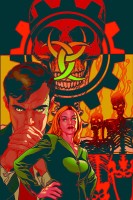 |
EX MACHINA #18
Publisher DC (Wildstorm) • Writer Brian K. Vaughan • Pencils Tony Harris • Inks Tom Feister
Man, this book is tough reading at the moment.
I've always liked Ex Machina, and it's not always the easiest read... but that's usually due to the occasional bouts of graphic nastiness in Tony Harris' exquisitely detailed art than it is to the stories being close to the bone. Admittedly, the book has always set out to be far more political and relevant than Vaughan's (and most people's) other work - witness the absolutely gobsmacking last page of issue one, where it's revealed that Mitchell Hundred managed to save one of the Twin Towers on September 11th - but even so, this is the furthest he's gone, and it's extremely uncomfortable.
It's early 2003, and an anti-war demonstration has gone horribly wrong, attacked by (we presume) terrorists who have unleashed ricin in aerosol form on the crowd. Mayor Hundred's former intern, Journal, is one of the affected, and she lies in a critical condition in hospital. Meanwhile, anti-Arab sentiment on the streets of New York has led to a gang of thugs carrying out a terrifying campaign of vengeance.
There are two kinds of story that Vaughan tells in Ex Machina - the tales of Hundred's days as a Rocketeer-style superhero, and the political machinations of his time in office as Mayor of New York (the entire series is told in flashback). The book works at its best when the stories are a combination of the two. Here, though, the superhero stuff is kept to a minimum - Vaughan is telling a deliberately relevant political story with this arc. That's not to say it's not done well - he keeps the intrigue burning, the dialogue is always strong (I wouldn't say he quite rivals Bendis in those stakes, but he's not too far off), and Tony Harris' name on a book is always a guarantee of quality art (incidentally, I wonder if this week represents the first time since Harris left Starman that its two original creators have had books out at the same time). It just doesn't make for entirely comfortable reading - largely due to its last few pages, which I have to warn you, border on distressing. That said, I would never describe an issue of this title as anything less than "worth reading". Just make up your own mind as to whether this world is something you want to see in your comics. B+
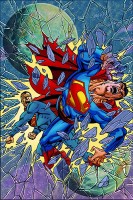 |
INFINITE CRISIS #5
Publisher DC • Writer Geoff Johns • Pencils Phil Jimenez, Jerry Ordway and Ivan Reis • Inks Andy Lanning, Jerry Ordway and Art Thibert
There's not quite as much going on in a single issue of Infinite Crisis as there was in Crisis On Infinite Earths - and it still has a slight feel of a self-contained miniseries rather than something that's going to completely change the shape of the DC Universe - but it's getting there. For example, in this issue, we get the death of one of the series' most integral characters (even though it's one who's said barely a few words since it began), the origin of a new hero (or, rather, a new incarnation of a far older one - the Jim Lee cover's a bit of a giveaway here), the appearance of another of Earth-2's heroes, and the terrifying return of a character we thought long gone earlier in the series. Oh, and the event that sparked off the closing pages of most of the pre-One Year Later issues, of course.
Still, though, the problems I mentioned earlier with the pacing of DC's various events this month seem to harm Infinite Crisis itself more than anything. One Year Later has got off to the best possible start with Robinson's Batman, while 52 looks more and more intriguing the more we see of it. We've already seen glimpses of the post-Crisis universe, and we're getting impatient for the rest. IC, therefore, you kind of just want to hurry up and get on with. Especially as a lot of the significant events appear to be happening in comics around the series proper.
It still makes for a quite entertaining read, though. I quite like what's being done with Booster Gold and the new Beetle, and Jimenez's art in these scenes is excellent. The Ordway-drawn Earth-2 sections, meanwhile, jar slightly as you adjust to the different artwork. His art in itself is quite a good fit for these scenes - especially with a great nod to the cover of the original Crisis #7 and a slightly less subtle one to Action Comics #1 - but it does feel a little incongruous to suddenly jump to it. The multiple Earths stuff is good, too (Overman!) with a great scene in the skies over Titans Tower. And it looks like what they're doing with Superboy Prime could be really rather fun (doesn't that outfit look a bit familiar? Surely he's not going to become... well, I won't say).
Still, though, as a whole it feels like an entertaining miniseries with a load of confusing stuff going on, rather than something genuinely epic that's truly essential reading. You get the feeling that you could cope just fine with DC's new universe if someone just told you what happened in Infinite Crisis and you started reading the OYL books and 52. B+
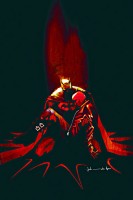 |
BATMAN ANNUAL #25
Publisher DC • Writer Judd Winick • Pencils Shane Davis • Inks Mark Morales
Speaking of books that are more about finding out what's going on rather than desperately needing to read them... comes this year's Batman Annual. Heavily hyped, of course, it's essentially Judd Winick's farewell to the title, and as the world and his wife knows by now, is the issue where we finally find out why Jason Todd's back.
They used to say "no-one in comics stays dead, except Uncle Ben and Bucky". Years later, that was added to "except Uncle Ben, Bucky and Jason Todd". Now, with Bucky and Jason being controversially resurrected within months of each other, it's hard to know what to think. Still, though, I suppose Hush showed that a slightly masochistic demand to see DC's most unpopular little brat return was evident among some fans of a certain age - and whether or not Jeph Loeb was just messing with us or genuinely wanted to test the waters, Winick has picked it up and run with it.
And, you know, the "Red Hood" storyline hasn't been half bad. Hardly classic, and not as strong as what's been done with Bucky over in Captain America, but still quite readable. However, much of the intrigue of the story has revolved around the mystery of just why Jason is back among the living - I have to say that with that question answered, I can't imagine him being a hugely viable prospect for long, post-Crisis.
And the problem here, really, is that although this issue is quite a well-told little yarn, it doesn't feel as essential a piece of reading as the previews, or indeed the "Red Hood" storyline as a whole, had made out. And the actual reason for Jason's return, well... not only is it extremely guessable, it's actually a combination of the two most obvious guesses. It's almost as if Winick felt as if one of the reasons on their own wouldn't be good enough, and so fudged the pair together. You can kind of see his point, though - without giving too much away, they both feel disappointingly vague. The part that ties into Crisis almost seems like a deus ex machina, lazy explanation that could be used for any number of things that have happened in the DCU in the past fifteen years; while the parts with Talia and Ra's just don't feel well-developed enough. Talia, in particular, doesn't seem to act hugely in-character, and Winick never gives us any indication as to why she cares so much.
Still, though, it's worth a look. There are some really quite good scenes in it - such as the well-publicised use of Jim Aparo's unused Death in the Family page for if the phone voters had chosen that Jason should survive - as well as the very unsettling moment that Jason actually makes his return (what is it about fingernails this week?). On the other hand, the tie-in to Hush is fairly fudged, with far too many questions left unanswered, and the whole thing feels a little unrevelatory - most of what occurs could quite easily be guessed, and it would be easy to fill in the gaps in your head if someone said to you "Yeah, this is how he came back". And the fact that it's in an annual, priced at $4.99, only adds to the slightly let-down feeling. B
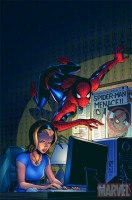 |
FRIENDLY NEIGHBORHOOD SPIDER-MAN #5
Publisher Marvel • Writer Peter David • Pencils Mike Weiringo • Inks Karl Kesel
Right, let's get this out of the way first - this issue has a massive plot hole in it. A massive plot hole. One that makes it kind of difficult to read the story as a whole without constantly thinking about it. At the start of the issue, a girl is writing a blog entry - which she calls a blog entry - around the time of Spider-Man's first appearances, and with Peter Parker still at high school. Now, obviously I understand that time in comics is fluid and you just can't say, now, that Spidey was first appearing in 1963. But still, if you're being charitable, the youngest it's possible to say Peter Parker is in "our" time is, what, late twenties? Which means that his first appearances would still have been around the early-mid nineties. And around then, while "blogs" may have existed, they certainly weren't called that, and they certainly wouldn't have been widespread enough for a popular, cheerleading teenager to be writing one. With a flatscreen monitor and a stack of CD-ROMs on her desk.
However, kudos to Peter David for actually bothering to explain himself. "Ten years from now there will be no reason whatsoever to portray Spider-Man's high school days as anything other than in the first decade of the 21st century, so feel free to think of the story as simply ahead of its time." And I like PAD, so I'm willing to give him the benefit of the doubt. Especially since - for what could arguably be called the "first" issue proper of this title now that all that The Other crossover nonsense is out of the way - he's turned in what is really a rather good issue, one of those standalone stories about how Spider-Man affects the people around him, of the sort that Paul Jenkins used to do so well in Peter Parker : Spider-Man a few years back. Basically, over the course of her entire life, this girl becomes convinced that a series of random encounters with Spidey - usually while he's fighting villains and not even noticing her - prove that he's stalking her. To the extent that she takes out a restraining order on him. The judge thinks she's nuts. J. Jonah Jameson thinks she's a hero. It's a good little meditation, though, on the effects that heroes can have on ordinary people. It also builds to a quite strong ending, with PAD providing a nice glimpse into the "future" of the character.
Weiringo's art is solid, but slightly disappointing; he seems like a good fit for Spidey, but based on his Flash and Robin work I'd expect something a bit more dynamic. Here, he seems a little restrained and simplistic. The whole look is a bit reminiscent of Mark Buckingham's Spidey work, but just feels slightly staid and uninspiring. He's capable of better, though, and I'm still keen on the idea of him drawing a Spidey title, especially a PAD-written one. I'm also quite looking forward to his take on the new costume, I think it'll suit him better.
As probably the first glimpse of what this title will be, it's a solid enough first issue, and it's nice to see the book carving out its own identity post-crossover (although this may not last long, since we've got bloody Civil War coming up). It doesn't quite pack the punch of one of those aforementioned Jenkins one-shots, but it's a breath of fresh air among the Spidey books at the moment, and a good indication of what they should really be all about. Promising - but a shame about the plot hole. A-
About this entry
- By Seb Patrick
- Posted on Saturday, March 04 2006 @ 8:04 pm
- Categorised in Comics
- 2 comments

I was considering reviewing FNSM myself, but upon actually reading it I couldn't bring myself to because I hated it so much that a reasoned opinion would've been hard. I thought it was a ridiculous writing. I agree with Paul O'Brien's suggestion - that the issue is basically about a mentally ill woman who wastes her life and then gets bitch-slapped by MJ at the end of it for no good reason other than she never got the help she needed. The obsession is clearly portrayed as nothing less than paranoid delusion and it just gives the story a distasteful edge to it.
Wieringo's art is the one thing I *do* enjoy in the issue, though. I remember when he did Spider-Man comics years ago and it was incredibly cartoony and energetic, but he's reined it in a bit and given it all a little more of a classic feel that I'm finding keeps things modern while pushing the correct nostalgia buttons.
And, obviously, the issue of blogs being around when Peter was in high school is pretty jarring, it's nothing I can't wrap my head around. It's fair to say it could quite easily have been a journal or something for the first scene though, the story doesn't hinge specifically on every piece of writing being public. The problem is that shoehorning it together just reinforces the idea that whole concept was invented working backwards from "Hey, Weblog makes a pretty decent pun..." which, while it's not necessarily the incorrect way to work, doesn't do the story any favours.
By James
March 07, 2006 @ 2:21 am
reply / #
I read O'Brien's review after having written my own, and I have to admit that that way of looking at it hadn't really occurred to me; and I'm still not 100% sure I agree with it, although I can completely understand why it's possible to take that perception from it. For starters, I strongly doubt that PAD intended it to read as harshly as it did - not that that should exempt him from criticism, of course - but also, it perhaps relies on a tendency to view someone like Mary Jane as being in the right when they appear. After all, just because she - from quite a biased viewpoint and without knowing the full extent of this woman's problems - condemns her so, does it mean that we the reader (or indeed PAD the writer) are supposed to?
I stand by my original review, though, simply because it was written without that reading of the ending being applied to it. Were I to have read the comic and written the review after considering such things, I may have approached it differently. On the other hand, a combination of that ending and the issue of the blog at the beginning (I agree that starting it as a journal and moving on to an online blog would seem a more natural progression) does make it seem like the word that can most aptly be applied to this issue is "misjudged"...
By Seb
March 07, 2006 @ 11:22 am
reply / #